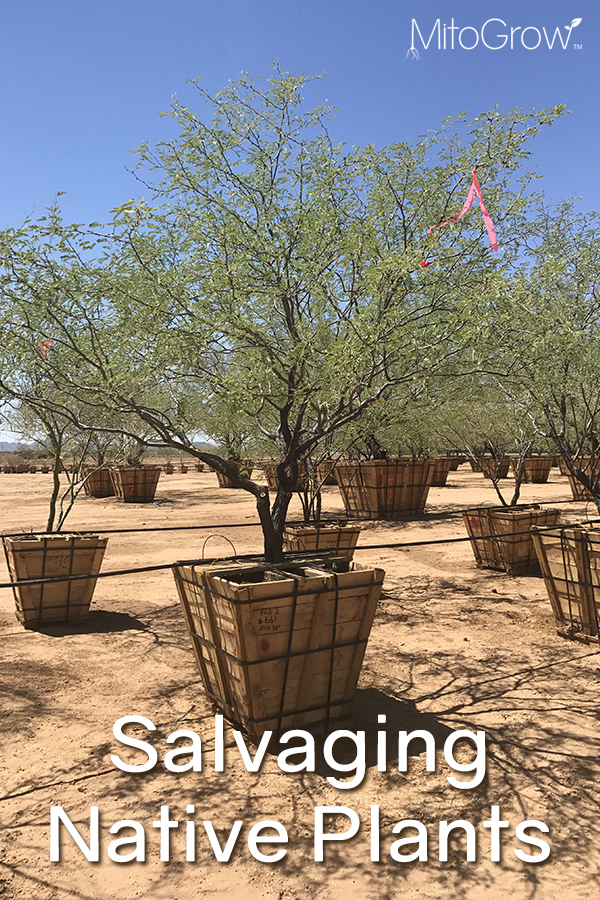Salvaging Native Plants
Salvaging Native Plants
The salvaging of native plants is a growing business. In the state of Arizona, several cities and counties require certain species to be salvaged to have construction or development plans approved, and this does not include state regulations someone may need to follow. Native plants shape a region and can add to economic development. Trees and plants add to the aesthetics of properties, whether they are residential or commercial, and in terms of tourism can make or break a locations appeal.
Paradise Valley, a town just outside of Phoenix, has six tree and four cacti species marked as protected native plants in its Native Plant Preservation Ordinance. The salvage process of native plants involves taking the plant to either a new location or relocating it to the same area once available. Developers are required to submit a plan of preservation to the town before beginning any work on the proposed site. To aid these developers, a list of native plant salvage contractors is provided by the town. One of these, Native Resources International, Inc. (NRI), has been in the game since 1994. Rob Kater, CEO & Partner of NRI, summarized his company as “a reclamation and landscape company that works with private and public entities whose focus is the salvage and restoration of native trees, cacti and shrubs throughout the greater southwest.”
One of NRl’s recent projects is located in Desert Ridge, which lies north of Paradise Valley. This project has differed from the others in that the trees were not exclusively treated with NRl’s usual nutrient and fertilizer blend. A project was conducted alongside its blend with three different fertilizers blended with MitoGrow™ product, Pellet 3-IA. The treatments were conducted in March and April of 2017, after which the trees were moved to an onsite nursery where they will be maintained for up to two years before being replanted on site.
When asked why he thought Pellet 3-IA blended with fertilizer could help NRI, Kater replied, “There is no question that the stronger and healthier, the more successful tree and shrub salvage will be. We believe that in addition to adequate watering, salvaged trees will benefit greatly from amendments that will promote stronger root recovery and growth.”
Results from the Project
The joint project was conducted on the following native species: velvet mesquite, blue palo verde, desert ironwood and an assortment of lycium species. Trees that were topically treated with Pellet 3-IA blended with fertilizers having NPK values of 8-8-8 and 12-12-12 were noticeably fuller and had greener foliage and a good number of trees that had borer damage were responding positively.
Kater’s own observations from the project were similar to that of the MitoGrow™ team. “It appears from our field and nursery work, Pellet 3-IA blended with 8-8-8 has been effective in helping the trees make the transition from field to nursery. It especially helped tree material that showed greater stress and recovery rate once brought to the holding nursery.”
The final recommendation from the project was found to apply Pellet 3-IA blended with the 8-8-8 fertilizer topically and to water on an as needed basis. Kater’s final thoughts and feelings towards the whole process is clear. “Even though the process of treating the trees takes extra time and cost, Native Resources has now begun a program in conjunction with MitoGrow™ to help identify which trees and in what stage of the salvage process its product would be most beneficial.”
Final Thoughts
“Native Resources would like to thank the MitoGrow™ team for their thorough approach to better understanding how their products can be of benefit to our company. Their personalized approach to our business has been absolutely awesome. We look forward to working together to develop more and more HAPPY trees for our customers.”
If you are thinking of relocating an established tree, contact a local salvage contractor or tree relocating company to have your tree evaluated. The best time to move established trees varies with the species and some types of trees have better survival rates than others. Remember to have your tree fertilized with Pellet 3-IA blended into it, prior to and after transplanting, to ensure it is given the best possible chance of surviving the stressful transplanting process.
To read the study report, please click here.
